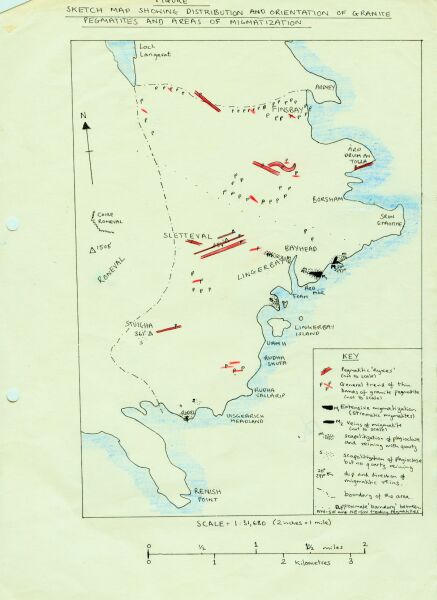
6. GRANITE PEGMATITES AMD MIGMATITES
(a) Granite Pegmatites
Distribution; The granite pegmatites occur in veins and dykes ranging in width from a few inches to over 90 feet and in length up to 2000 feet. These veins and dykes are common over much of the area and especially abundant to the west and west north west of Finsbay post office. Only the thicker dykes are shown on the 1:10,560 scale geological map but figure 4 shows the general trends, and an indication of abundance, of pegmatite veins. The pegmatite veins to the north and east of Strath Leetein generally have a NW—SE trend while those to the south and west generally trend WSW-ENE. The former are apparently concordant to the 'granitic injection complex' to the north of this area (Dearnley 1963).

Fig 4: Distribution of granite pegmatites & migmatites
Lithology; These rocks are generally very coarse-grained, with phenocrysts of white or pink microperthite up to 5 feet long and black biotite laths up to 3 feet long.
Microscopic examination of a specimen from the quarry on Sletteval showed that the pegmatites consist dominantly of a pale microcline-albite microperthite with veinlets of granoblastic quartz. Biotite occurs in patches, which are less frequent towards the margins of dyke. Minor constituents include zircon and ?thorite (see van Knorring and Dearnley 1961 for a fuller list). Biotite is often altered to a deep green mineral (probably another mica) and occasionally shows black 'haloes' round minute inclusions of minerals which are probably radioactive (plate 4). The feldspars are very fresh, in contrast to most of those seen elsewhere in the area.
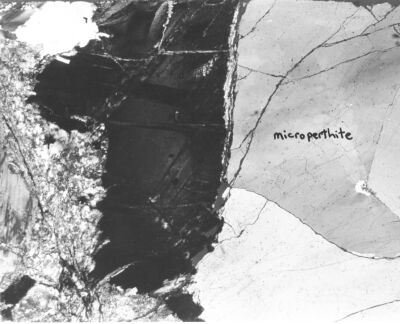
Radioactive haloes in biotite (the dark mineral)
Age and Origin; The pegmatites cut the foliations of all the gneisses and have been radiometrically dated at 1750 - 1715 million years (van Breeman et al 1971).
The pegmatitic dykes of the Loch a'Sgurr and Sletteval areas are clearly dilation pegmatites, since they demonstrate a decrease in grain size towards their margins, suggesting chilling. 50 yards ENE of the south western end of Loch a'Sgurr a folded pegmatite vein encloses a xenolith of hornblende-quartz gneiss, also suggesting dilation rather than replacement.
The smaller pegmatite veins usually grade into the country rocks and are probably replacement pegmatites.
(b) Migmatites
Lithology; In hand specimen, the rock types described here as migmatites are medium-grained (about 1.5mm on average), quartz-rich feldspathic gneisses in which certain features characteristic of migmatites are present (Mehnert 1968). Microscopic examination of a migmatite, collected 425 yards ENE of the southernmost point of Ard Mor, shows what probably represents a typical composition: 43% scapolitised plagioclase, 41% quartz (in veinlets) and 13% hornblende, with minor chinopyroxene. The plagioclase is almost completely altered (plate 6) and the hornblende is probably the result of alteration of clinopyroxene.
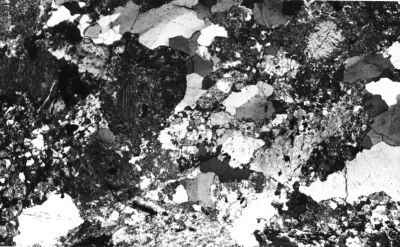 | Plate 6: Scapolitisation of plagioclase in migmatite |
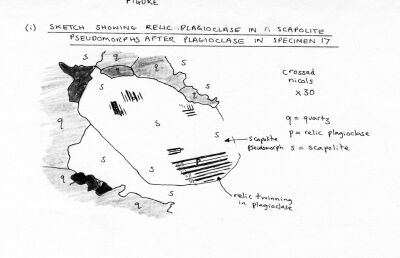 | Sketch of key elements in Plate 6 |
Many outcrops in the area where this specimen was collected also show 'resistors' (Mehnert 1968) of amphibolite, boudinaged, with the foliation of the migmatite 'flowing' round the boudins.
Plate 5 also shows boudins of amphibolite in this area. 300 yards east of the aforementioned migmatite, veined migmatites are exposed. These veins are generally about 2 feet wide and dip at 20° to 297°. They often show margins of amphibolite extending up to 3 feet into the host rock, which is a garnet — pyroxene — feldspar gneiss.
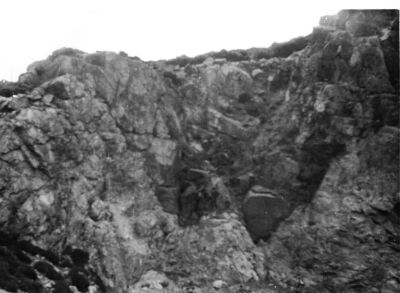
Plate 5: Boudins of amphibolite
Age and origin: It is reasonable to suppose that the migmatisation occurred at approximately the same time as intrusion and injection of the granite pegmatites. Evidence from the 'granite—migmatite injection complex' to the north of this area apparently suggests that the pegmatites slightly post-date the migmatisation (Myers 1971). The migmatites probably formed by local partial melting of the host rocks and flowage of the resultant granitic fluid. Therefore, they are probably associated with amphibolisation of pyroxenes, and probably, by the release of volatiles, with the alteration of feldspars, observed in the rocks of the 'igneous complex'.